Everyone loves dressing up for Halloween. Then there are those tailgate parties that demand you don your team’s colors – from head to toe. And plenty of people join in and attend Pride Parades around the country. That means an explosion of color. People LOVE costumes and changing their hair. So it’s no surprise that the trend’s extended to the canine world. A quick search around social media will reveal dogs in every color you can think of. You’ll see patterns, elaborate creations, and even simple shadings on ears and tails. Dog hair dyes are the newest trend to gain popularity. And while they seem harmless enough, there’s a dark side people may not recognize. Before you reach for that “Charm Pink” or “Vital Copper” dog hair dye on the shelf? Make sure you understand the risks.
Hair Color
Dyed hair in people started as taboo. Maybe you touched up the grays, but wild colors? That was relegated to certain groups (usually with unflattering labels). It’s only in recent years that colored hair received a warmer welcome. And as more and more people started turning their hair blue, purple, pink, and even unicorn or mermaid (real options – ask your hairstylist), they started considering the same options for their favorite furry friends.
But dog hair dye is tricky. It doesn’t show up on every hair color or work with every type of coat. Dogs with darker colors? You can attempt color changes, but you probably won’t get good results. It’s white hair that works best for providing vibrant results. (Apricot’s an option, but it won’t hold as long) And you need fine hair – not fur – if you want the BEST chance for a colorful canine. So that limits your options to (primarily):
That isn’t to say you HAVE to follow those recommendations. And plenty of people don’t. But that’s part of the problem behind dog hair dyes. And it’s where plenty of pups end up miserable, injured, or even hospitalized. Because while hair color is fun to experiment with (for humans), it’s NOT safe to play around with in canines.
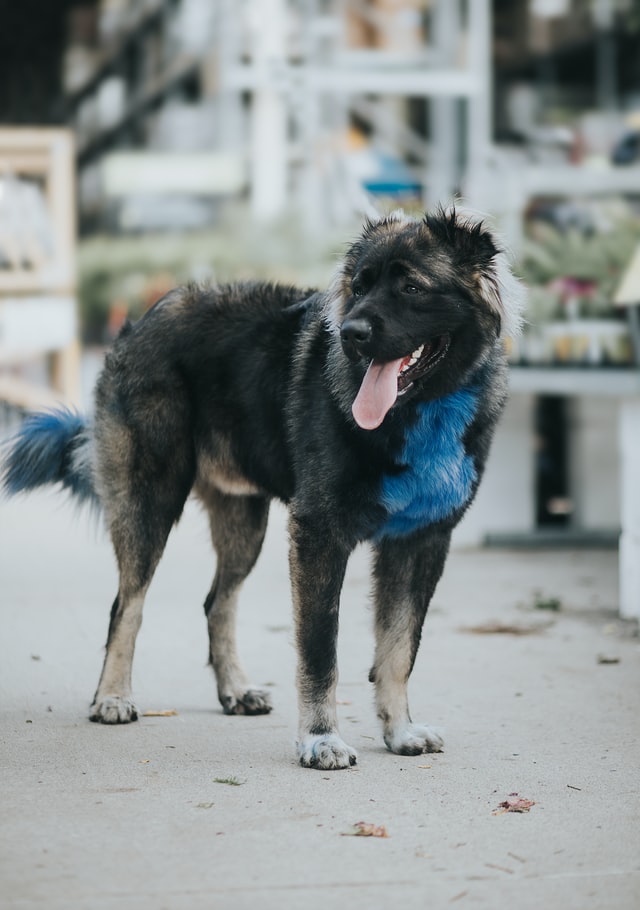
The Dyeing Process
Four states (Colorado, Florida, Maine, and South Carolina) have laws against the use of dog hair dyes. Actually, the laws protect ANY animal from the dyeing process. They don’t care whether you use a non-toxic, animal-safe dye or not. If they catch you, you’ll end up charged with animal cruelty and face fines. That’s how seriously they take the issue.
And for a good reason. Dog hair dyes aren’t simple. And neither’s the process. If you’ve never changed the color of YOUR hair, you may not understand. And all of those videos on the internet? They don’t convey the process very well. They make it appear as if you cheerfully brush on the color, and voila! You get a pup with rainbow ears.
But dog hair dyes involve similar chemicals to the ones used in humans. Especially when you pick up tubes and jars labeled “permanent” or “semi-permanent.” How else do you think that color lasts beyond a few moments? You need compounds that bind to the hair. And while dog hair dyes skip the bleaching process humans use, they’re not any less harsh on hair. Take it from someone who knows.
I dye my hair. (Well, I don’t, my hairstylist does it, so I don’t end up looking like a disaster) It’s been blue, purple, green, and pink. Each time, I need to undergo a bleach (which IS harsh), a tone, and then the color. It takes two hours – and I have short hair! And then I have to take care of it – with special shampoos and conditioners and avoid the sun and chlorine. That’s A LOT to expect from a dog. But it’s only the tip of the iceberg when it comes to the dangers of dog hair dyes.
Dog Hair Dye Dangers
When owners reach for dog hair dyes, they’re thinking of doing something fun. They’re not thinking about the impact on their pup. It’s a fad and a trend. And, all too often, it’s a way of turning a beloved pet into a fashion accessory. Because no one stops to ask their dog whether they want to undergo the coloring process. Granted, we can’t understand our dogs when they bark. But we CAN comprehend their health and well-being. And if you stopped to look at those aspects? You’d skip the dye aisle.
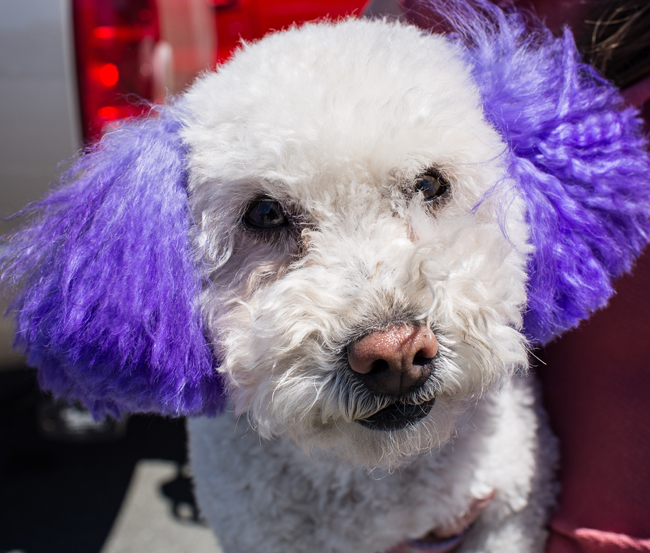
Dog Hair Dyes and Baths
Even dog hair chalks and blow pens require bathing to remove the color. They aren’t as messy to deal with as liquids and gels, and they won’t last as long, but your dog has a bath in their future. And some shades? They require more baths than others. Your dog may need TWENTY baths to remove all of the color from a dog hair dye in some cases. That’s too much. And it’s going to lead to serious problems.
All dogs have natural oils in their fur. The oils give that sleek shine that makes a pup look healthy. And in the breeds that have a penchant for swimming, it provides a waterproof coating. But when you reach for the shampoo too often, you pull all of the oil out of their hair. This means your dog WON’T be as waterproof. Their hair will also dry out and thin. And that goes double for the skin underneath. Dry skin leads to itching, irritation, and possibly even infections.
And the problems don’t stop there. The ears are the most common site for dog hair dyes. So when you scrub the ears down the road to remove the color, you end up getting water close to and possibly IN the ear. That means a higher risk for ear infections. If you see your dog shaking their head, you need to get to the vet ASAP.
Dog Hair Dyes and Behavior Changes
People? They love dogs with fun colors and stencils. But when you use dog hair dyes, you disrupt your furry friend’s world. They don’t look like themselves, and they don’t SMELL like themselves. And that can lead to a complete 180 in the way they interact with the outside world, their usual doggie friends, or even YOU.
Some dogs may tolerate sitting still for the time it takes to apply dog hair dye. If you have a canine that tolerates lengthy grooming sessions, it’s possible. But if this is the first time they’ve experienced the need to hold still for long periods? You could see signs of anxiety. And it’s not fair to put your dog through that ordeal for something that isn’t necessary.
And no matter what kind of dog hair dye you use, it STINKS. Perhaps not to you, but to other canines? To disguise the chemicals that create the colors, companies add artificial scents. (It works the same way with human dyes) And they aren’t reaching for smells your dog would approve of. That means your pup has to cope with smelling like something foreign. And when they hit the dog park? Their doggie friends don’t recognize them anymore. It can lead to confrontations.
Hopefully, your dog isn’t shy, either. Because EVERYONE’S going to come up to them and want to cluster around. Remember, people love colorful dogs. So when you reach for dog hair dye, you’re drawing social attention to your beloved pup. And if they don’t like having people around them, it’s an invitation for disaster.
Health Risks of Dog Hair Dyes
One of the first rules people tell you about dog hair dyes is to avoid the nose, eyes, and mouth. It’s a good rule as even non-toxic formulations shouldn’t get ingested. But there’s a wrinkle: dogs lick. They lick you, and they groom themselves. So even if you avoid the face, your dog will probably reach that color, eventually. And if you read the fine print on a bottle? You’ll probably see warnings to avoid licking.
Those same “dog-safe” products are never a guarantee against problems. You’re dealing with chemicals. And many dogs can suffer allergic reactions. If you read the directions, you’ll see a recommendation to perform a “test patch.” This is intended to check for possible allergies. But plenty of people skip over this step. And it’s also possible that you won’t see the itching, rashes, or hives until you’ve used the dog hair dye throughout your dog’s body. Then you have the problem that removing it? Yeah, it’s going to take FOREVER!
And if you grab a HUMAN hair dye? The results can be deadly. Human dyes DO contain that bleaching agent. They’re also designed with human hair in mind. The chemical composition is different. Your dog can suffer from chemical burns, sometimes so bad they compromise the skin. And, again, removing the dye in a hurry? That doesn’t happen.
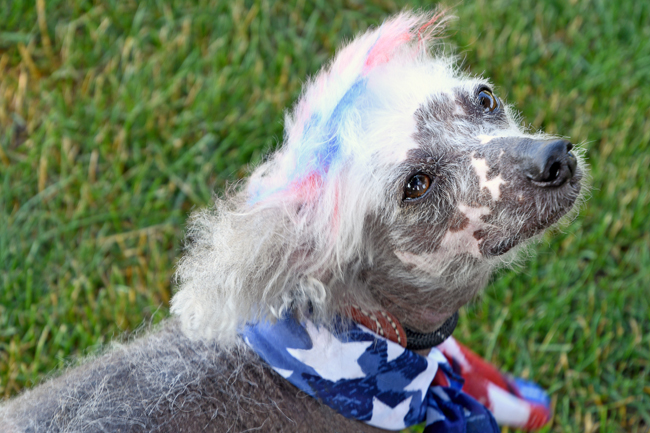
Playing it Safe
So far, no one’s studied the long-term effects of dog hair dyes. The closest is a 1989 case Clairol performed. The frequent application of hair dye and bathing led to split and peeling hair, dry and irritated skin, and hyperactive and restless dogs. True, that was a safety study, where the dye ended up applied 80 times a day (unreasonable for ANYONE). But it still suggests a problem.
Unfortunately, dog hair color doesn’t seem to be going anywhere. And grooming salons are finding themselves with requests they feel uncomfortable with. You’ll often find them making statements regarding dog hair dyes. Before you decide to change your dog’s beautiful natural color, you need to ask yourself: “Am I doing this for a good reason?”
If you DO want to experiment with color, your best bet is to use natural options. Fruit and vegetable dyes WILL provide a change to your dog’s hair without posing as many risks to their health or well-being. They won’t last as long, but that also means you won’t need to fret about over-bathing your dog. And you’ll still find a nice palette of colors to choose from:
- Blue: Blueberries
- Pink: Raspberries
- Purple: Blackberries
- Red:
- Beets
- Cherries
- Cranberries
- Strawberries
You can also use Kool-Aid, but you MUST look at the package carefully. You don’t want any sugar-free versions. They contain xylitol which is toxic to dogs. (And you know your dog is going to lick that dyed spot eventually) Whether you use the fruit/vegetable dye or Kool-Aid, all you need to do is mix it with water. Then you can rinse it into your dog’s hair. Simple as pie.
Fashion Faux Paw
There’s nothing wrong with expressing your individual personality. Everyone should do so. But when you reach for dog hair dyes, you may be getting close to a dangerous line. Your pup is a friend and family member – not an accessory. And those chemicals AREN’T safe for their health or well-being. Even if you choose products intended for use on dogs, you’re running a big risk. It’s not worth it.
Instead, consider finding a fun collar in the same colors you prefer. Or you can even choose a vibrant dog sweater. Your dog will look just as enchanting – without putting their body on the line.




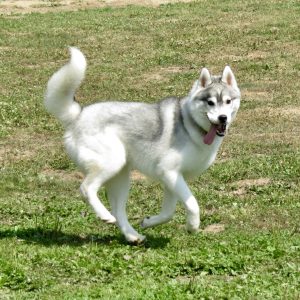



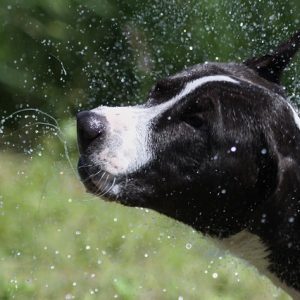




No comment yet, add your voice below!